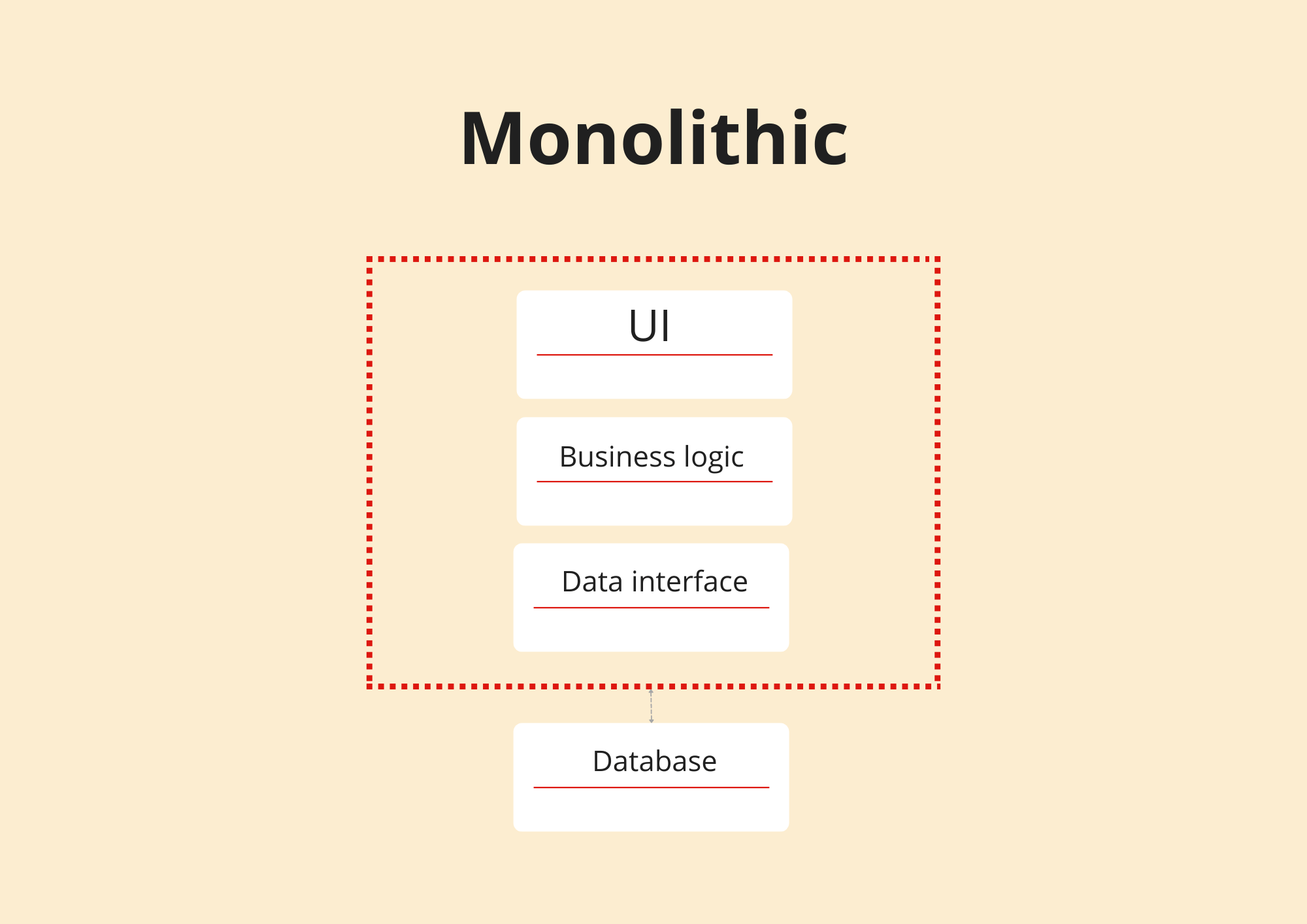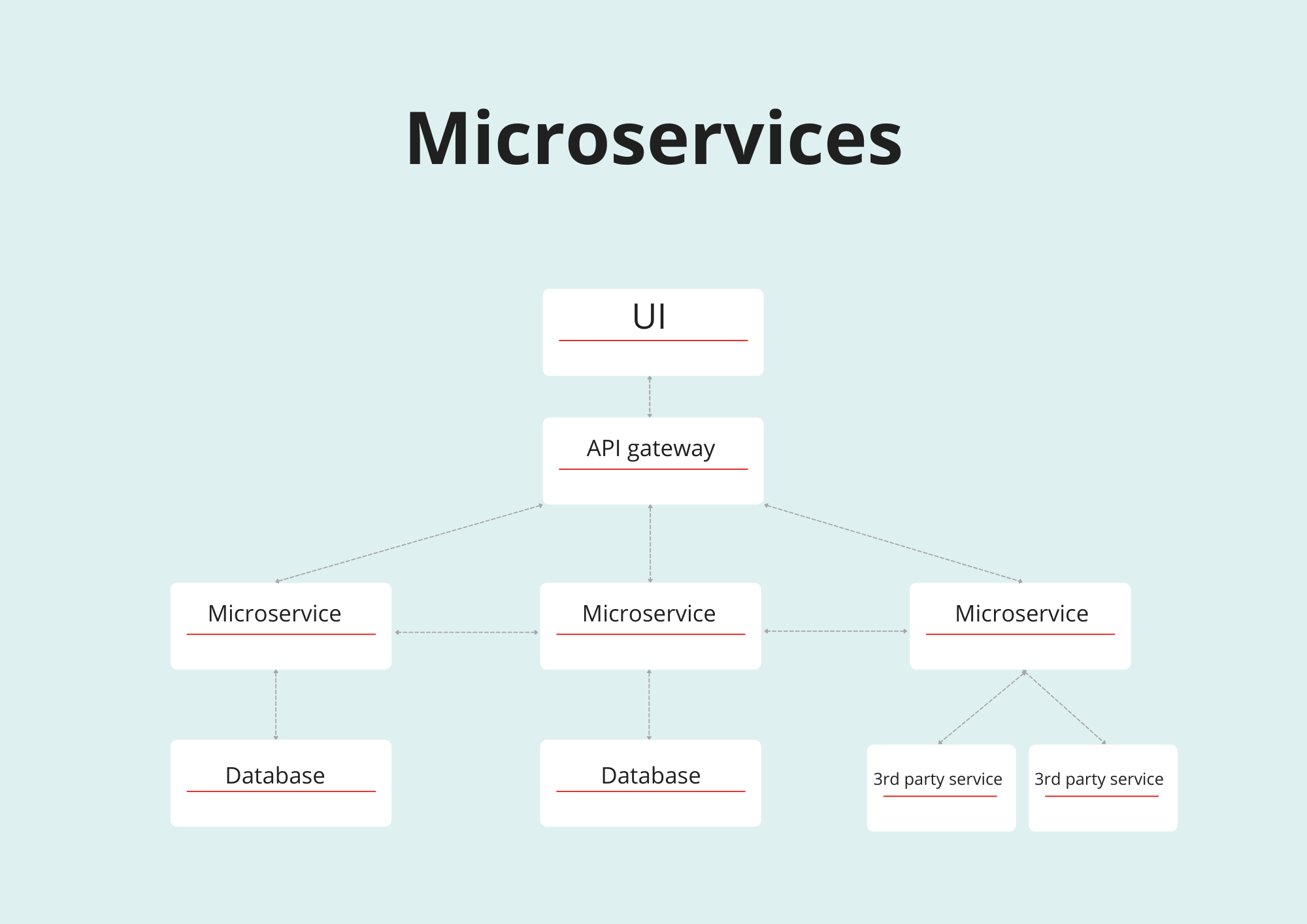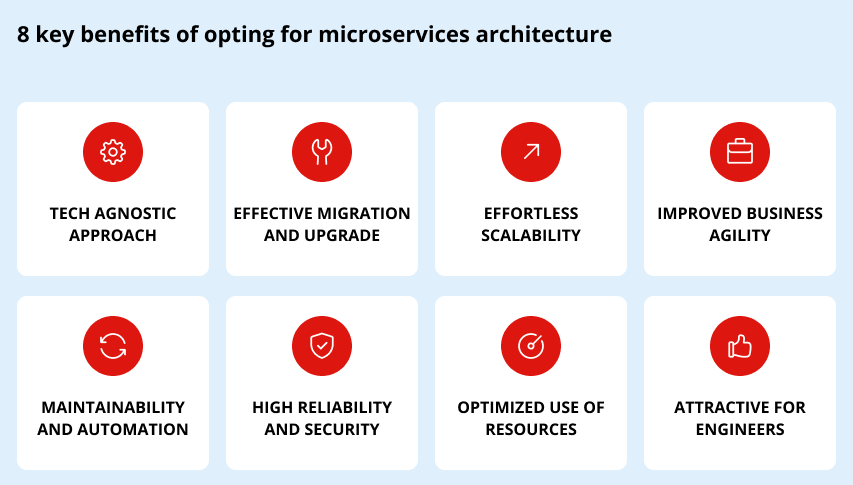Microservices vs. Monolithic Architecture: Compare Pros and Cons for Business
Monolith is the classic of software architecture, microservices is the progress. Both approaches are valid for building high-performing applications. However, they address different requirements and business needs.
Comparing monolithic vs. microservices applications will help you understand what fits you best and figure out if it’s time to move from one design to the other one.
You will find answers to the common questions about the monolith vs. microservices dilemma in this post. PLUS, a real-world migration example with business outcomes.
- What is monolithic architecture and what is microservices architecture?
- What are the pros and cons of each approach?
- Microservices architecture vs. monolithic architecture: how do they compare?
- Real-world use cases for using monolithic and microservices approaches.
- When to consider migrating from monolith to microservices and why?
Monolithic architecture is a classic approach to building an application as one undivided unit. Such applications consist of several layers – user interface, business logic, and data access that connects to a database. This relatively simple structure makes monoliths fast and easy to build and support. Until they grow too big.

All components in a monolithic application are closely connected (or tightly coupled) and must be operational for the software to run. This is the fundamental difference between a monolith and microservices that are loosely coupled. Changes in one component usually affect the rest of the system. So when some part of an application needs an update, it often requires updating and redeploying the entire system.
Despite the undeserved bad rap that has been circling monoliths recently, this is still one of the most popular methods of building applications. And for a good reason.
Pros of monolithic architecture
Easy to build and deploy
Monolith is a straightforward design approach that is fairly easy to implement. It has a simple structure and a single codebase that can be deployed at once. All this makes monolithic architecture the first choice for building small lightweight applications.
Fast cost-effective development
Monolithic architecture also works as a starting point for MVPs and other projects with tight deadlines. Mainly because it is fast to design and develop and good for time to market. Familiar style to practically all developers, it doesn’t require hard-to-get costly expertise, which is often a barrier for microservices implementation.
Simple testing and debugging
If you compare monolithic vs. microservices architecture, monoliths will often beat microservices in testing and debugging. Why? Because it is easier to test, track down errors, and fix bugs when you have only one codebase. Unless, of course, monolith grows into a large unmanageable system, which leads us straight to the next section.
Cons of monolithic architecture
Monolithic architecture works just fine until it doesn’t. As an application increases in size and complexity, it starts revealing several disadvantages of this design approach.
Hard to scale
A monolithic application scales evenly. So the bigger it grows, the harder and more expensive it gets to scale an entire system. It also lacks flexibility when it comes to modernizing or migrating to new platforms and frameworks.
Prone to crashes
The phrase “if I’m going down I’m taking everybody with me” is spot-on for this design approach. Since all components in a monolithic application are closely connected, an error or crash in one part may affect the operation of the whole system. This impacts the overall reliability of the application and, as a result, business outcomes. This, in turn, explains why many companies rule out monoliths when choosing between monolithic and microservices architecture.
Offset the benefits with growing complexity
All the benefits of monoliths – fast cost-effective development, easy deployment and debugging – may fade as the application gets bigger. The codebase may become cumbersome and hard to manage, understand and troubleshoot. It may take more time to develop new functionality and deploy the entire system every time some changes are made.
At this point, many businesses begin to compare monolithic vs. microservice architecture and consider migrating to a more flexible approach.

Microservices architecture is an industry-proven method of building applications out of separate distributed modules (microservices) each focused on one business function or service. These modules use APIs (often RESTful) and API gateways to connect with other services, client apps, and other applications in the organization. The API-driven approach enables loose connections and weak dependence between components.
Each module in a microservices application has its own business logic, database, and often an individual tech stack that can be completely different from the rest of the system. As a result, you can deploy and scale microservices independently. All this provides great flexibility both for business and engineering teams.
The first step to comparing microservices vs. monolithic applications is to see when they outmuscle each other and why.
Pros of microservices architecture
Easy to scale, manage, support, and update
As we mentioned a moment ago, microservices enable flexibility. Modular design allows to scale services unevenly depending on growing load, new technical requirements and business needs. This results in better agility and helps businesses adapt to fast-changing markets.
Example: Our long-standing client, a leading US photo lab, runs a high-load web system for professional printing services. The system consists of dozens of applications for B2B and B2C customers and works with hundreds of gigabytes of image data daily. In 2020, we kicked off migration to microservices and system modernization. The key goal was to improve the performance, scalability, and visibility of the entire system and every component in particular. Since the beginning of the project, we saw a 4x increase in performance in a complex book rendering process. Now it can manage 4 times more customers without decreasing the overall speed of rendering hi-res photo products. For this business, it means excellent performance and NO lost sales during seasonal peaks.

Modularity also makes it easier to manage and support an infrastructure that consists of smaller individual services compared to one huge codebase. And finally, the tech-agnostic approach allows teams to update components, migrate to new frameworks and try new technologies within one service without costly large-scale refactoring.
High reliability
Microservices applications are fail-proof and resilient thanks to independent deployment and low dependence between modules. A problem occurring in one service is unlikely to affect the rest of the system. This is perhaps one of the primary advantages of microservices over monolithic architecture for large enterprise-grade applications.
Effective engineering and deployment practices
Shift to microservices triggers changes not only in the design but in the entire development ecosystem. Microservices promote frequent deployment, DevOps automation, modern CI/CD and testing, and team autonomy. Needless to say, it is attractive for top-tier developers who prefer working with modern tech stack and engineering practices.
Access agile teams and tools for microservices development
Adopt and scale microservices without exceeding your budget and losing sight of your key business goals.
microservices expertiseIf you are curious to learn more about how adopting microservices affects business outcomes, check our separate blog post on the benefits of microservices architecture.

Cons of microservices architecture
Despite its growing proliferation, microservices architecture is not a one-size-fits-all solution. Moreover, after weighing all pros and cons of monolithic architecture vs. microservices architecture, many small and medium-sized businesses understand that it’s overkill for their applications. Here’s why.
Increasing complexity
As the number of services grows, so do the number of communication points and the overall complexity of the system. It requires more resources to support, coordinate and orchestrate the infrastructure. Not to mention the challenge to create frictionless communication between services and autonomous teams.
More time to test and debug
If you want to learn about the disadvantages of microservices, ask a test engineer. On one hand, debugging a small service is easy because it is isolated from the rest of the system. On the other hand, there are multiple services – dozens or even hundreds in large systems – and each has its log and tech specifications.
Plus, there are multiple connection points, so more things can potentially go wrong. However, this disadvantage can’t beat the reliability of modular microservices architecture vs. monolithic applications that work as one undivided unit.
Upfront cost and extra expertise
Cost is one of the biggest barriers that prevent businesses from adopting this approach. Generally, it takes more time and a bigger team to develop and support microservices. Additionally, it requires certain expertise to understand how to split applications into business-critical services, then plan, engineer, and manage the system.
We get it, this is a lot to process. Let’s take a breather and make a quick recap with a side-by-side comparison of monolithic architecture and microservices. This review will help you understand which design better fits your business requirements and capacity.
Structure
Microservices have a complex structure that consists of various heterogeneous services and databases. Monolith has a simple straightforward structure of one undivided unit.
Flexibility
You can update, rewrite and modernize individual microservices independently from the rest of the system. It provides great flexibility and helps avoid tech lock-in. Monoliths are less flexible since changes usually cover the entire system.
Scalability
Monolithic application is scaled as a whole, unlike microservices that can be scaled unevenly, saving business and development teams a lot of time and resources. This difference between monolithic and microservices encourages companies to migrate their rapidly growing applications to microservices to drive agility and enable a more cost-effective approach to development.
Example: Breaking down a large web application into microservices allowed us to significantly increase visibility and gather performance metrics for each individual service. Now we can dynamically control the use of infrastructure resources depending on business priorities, e.g. scale up and down certain services to respond to increasing load.
Deployment
You can deploy different components in a microservices application independently. This enables frequent deployment and CI/CD automation. On the other hand, a monolithic application provides fast and easy deployment of the whole system.
Development team
Monolithic architecture and microservices can be built with the same set of skills. However, microservices provide better flexibility when it comes to team composition, distribution of tasks and ownership.
Resilience
Microservices applications are more resilient thanks to independent deployment and loose coupling compared to tight coupling in monolith applications.
Troubleshooting
Large monolith is harder to troubleshoot due to various dependencies and tight links between system components. Microservices, on the other hand, enable fast and easy problem tracing and troubleshooting.
You can review the comparison of microservices vs. monolithic architecture in the table below.
| Compare | Microservices | Monolith |
|---|---|---|
| Structure | Modular | One unit |
| Flexibility | Diverse tech stack | Single tech stack |
| Scalability | Scale individual services | Scale entire application |
| Deployment | Deploy individual services | Deploy entire application |
| Time to market | Long | Fast |
| Cost | Original cost is high, reduces over time | Original cost is low, increases over time |
| Reliability | Resilient thanks to service autonomy | Vulnerable due to close coupling |
| Visibility | High | Low |
| Troubleshooting | Easy | Harder as the application grows |
Comparison table: Monolithic architecture vs microservices
MVPs, prototypes, PoCs
Monolithic architecture is optimal for small-scale initiatives where the primary focus lies in testing an idea or demonstrating a concept. Cost-efficiency and simplicity of a monolithic application vs. microservices make it a great fit for MVPs, prototypes, and PoCs. It enables swift development, testing, and validation of a concept before considering a more complex architecture. However, bear in mind that it may be hard to scale up.
Simple lightweight applications
Monolith is a tried-and-true solution for lightweight applications with one or limited business functions. For example, an online booking tool or an internal scheduling application for employees. So if you build an application with straightforward requirements and minimal complexity, a monolithic approach is enough.
Resource-constrained environment
Monolithic architecture is a practical and cost-effective choice for projects with limited budgets and scarce resources. If you compare a monolithic vs. microservice architecture in terms of implementation and support costs, the former usually doesn’t require specialized technical expertise and significant resources.
Scalable platforms and SaaS
Microservices is a modern web app architecture designed for scalability, resilience, and agility making it a perfect fit for fast-growing platforms and SaaS that constantly evolve, expand to new markets, and add new features and functionalities. This approach provides seamless scale-up and painless transition to new technologies. That’s why so many companies decide to move from a monolithic architecture to microservices once they pass the MVP stage.
Enterprise applications
Large enterprise software with multiple applications, modules, integrations, and various data sources benefits from the modular architecture of microservices. This approach offers flexibility, reliability, and enhanced data security. Moreover, microservices adapt well to the unique requirements and infrastructure of large organizations.
Data-driven solutions
Modular independently scalable microservices are beneficial for cloud-native data-driven applications enabling better performance and enhanced data security. Microservices isolation provides reliability and resilience to overloads, which is crucial in data-intensive applications.
You will need to consider many factors when choosing between a monolithic architecture vs. microservices: your goals, resources, timeline, tech expertise, scalability, performance, and security requirements, integrations, support costs, and even your organizational structure. Here are a few shortcuts that will help you make an informed decision.
5 reasons to choose monolith
- Predictability. A monolithic application is a predictable environment with one codebase. If you stick to one business workflow and don’t expect significant changes or scale-up, then consider this approach for your system.
- Simplicity. The straightforward design pattern of monolithic architecture makes it easy to develop, deploy, and manage. So if you are looking for simplicity, this is your best pick.
- Speed. When comparing monolithic vs. microservices architecture, remember that the former wins the sprint, and the latter wins the marathon. To get your project out the door as early as possible, choose monolith.
- Cost-efficiency. Monolith is an obvious choice if you have a tight budget. It is predictable, familiar, and doesn’t require specialized expertise and significant resources to design, develop, and support.
- Easy support. If you aim for effortless support and your application is relatively small and simple, consider monolith with a single codebase.
5 reasons to choose microservices
- Scalability. Choose microservices to meet high scalability requirements and growth potential. If your existing system consistently shows performance issues during increasing load, it could be a sign to consider migrating your application from a monolith to microservices.
- Resilience. Isolate well-defined business functions and transform them into individually deployable, independent microservices. This will make your system more stable and resilient to crashes.
- Business agility. Scale, rebuild, or migrate individual components to new technologies to dynamically respond to changing business priorities or market needs. It’s cheaper and more resource-effective with microservices vs. monolith architecture.
- Productivity. Gain speed with agile development approach, automated testing, and deployment. With microservices, you can split your team to focus on individual business components, enabling faster delivery.
- Integrations. Leverage an API-driven approach to seamlessly expand the functionality of your system with third-party services and tools. Fast and cost-effectively.
Effortlessly build and expand microservices with Digiteum
Whether you consider migrating to microservices and need an experienced partner to help you plan, estimate and implement your project without risks. Or want to up your game and expand microservices by adding agile specialists to your team, you can leverage your experience and microservices development services.
Our expertise includes:
- Development and support of a microservices-based solution for precision medicine (UK) in a record 8-month timeframe. Read the full story…
- Scaling .NET team to develop and support a large distributed platform for a travel tech company (ES). Read the full story…
- Complete cycle of migration from monolith to microservices, including planning, estimate, implementation and support of a high-load web system for a photo printing service provider (US). Read the full story…
Leverage time-proven microservices expertise
Get maximum value from modular architecture without risks and uncertainties related to costs, resources and organizational changes.
Hire microservices expertsQuick round-up
- Monolith and microservices address different requirements and suit different organizations depending on size, goals and team composition.
- Analyzing the pros and cons of microservice architecture vs. monolithic architecture will help you understand which design works best for your project goals and available resources.
- Reviewing the difference between monolithic and microservices architecture with examples and use cases will give you an idea of what fits best for your organization and business needs.
- If you believe that your monolithic application outgrew its capacity and became too complex to support and maintain, it could be time to consider migrating to a modular architecture. Start with a detailed comparison of microservices and monolithic design styles to see how this transition could help you solve your current issues and what business benefits it could bring.
This post was originally published on October 22, 2022 and updated on November 3, 2023.







